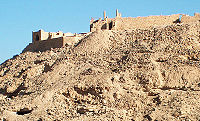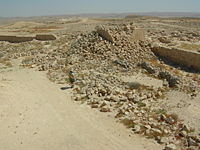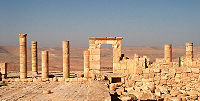
Avdat
Encyclopedia



Petra
Petra is a historical and archaeological city in the Jordanian governorate of Ma'an that is famous for its rock cut architecture and water conduits system. Established sometime around the 6th century BC as the capital city of the Nabataeans, it is a symbol of Jordan as well as its most visited...
between the 7th and the 1st centuries BCE. It was inhabited by Nabataeans, Romans and Byzantines. It was a seasonal camping ground for Nabataean caravans travelling along the early Petra - Gaza road (Darb es-Sultan) in the 3rd - late 2nd century BCE. Avdat was named for Nabataean King Obodas I
Obodas I
Obodas I was King of the Nabateans from 96 BC to 85 BC. He was the successor of Aretas II, from whom he inherited the war with the Hasmonean kingdom. He defeated them around 93 BC on the Golan Heights....
who was revered as a deity and, according to tradition, was buried there.
History
Before the end of the 1st century BCE a temple platform (the acropolis) was created along the western edge of the plateau. Recent excavations have shown that the town continued to be inhabited by the Nabataeans continuously from this period until its destruction by earthquake in the early 7th century CE. Sometime towards the end of the 1st century BCE the Nabataeans began using a new route between the site of Moyat Awad in the ArabahArabah
The Arabah , also known as Aravah, is a section of the Great Rift Valley running in a north-south orientation between the southern end of the Sea of Galilee down to the Dead Sea and continuing further south where it ends at the Gulf of Aqaba. It includes most of the border between Israel to the...
valley and Avdat by way of Makhtesh Ramon
Makhtesh Ramon
Makhtesh Ramon is a geological feature of Israel's Negev desert. Located at the peak of Mount Negev, some 85 km south of the city of Beersheba, the landform is not actually an impact crater from a meteor, but rather is the world's largest makhtesh. The crater is 40 km long, 2-10 km wide and 500...
. Nabataean or Roman Nabataean sites have been found at excavated at Moyat Awad (mistakenly called Moa of the 6th century CE Madeba Map), Qatzra, Har Masa, Mezad Nekarot, Sha'ar Ramon (Khan Saharonim), Mezad Ma'ale Mahmal and Grafon.
Avdat continued to prosper as a major station along the Petra
Petra
Petra is a historical and archaeological city in the Jordanian governorate of Ma'an that is famous for its rock cut architecture and water conduits system. Established sometime around the 6th century BC as the capital city of the Nabataeans, it is a symbol of Jordan as well as its most visited...
-Gaza
Gaza
Gaza , also referred to as Gaza City, is a Palestinian city in the Gaza Strip, with a population of about 450,000, making it the largest city in the Palestinian territories.Inhabited since at least the 15th century BC,...
road after the Roman annexation of Nabataea in 106 CE. Avdat, like other towns in the central Negev
Negev
The Negev is a desert and semidesert region of southern Israel. The Arabs, including the native Bedouin population of the region, refer to the desert as al-Naqab. The origin of the word Neghebh is from the Hebrew root denoting 'dry'...
highlands, adjusted to the cessation of international trade through the region in the early to mid 3rd century by adopting agriculture, and particularly the production of wine, as its means of subsistence. Numerous terraced farms and water channels were built throughout the region in order to collect enough run-off from winter rains to support agriculture in the hyper arid zone of southern Israel. At least five wine presses dated to the Byzantine period have been found at the site.
In the late third or early 4th century (probably during the reign of Diocletian
Diocletian
Diocletian |latinized]] upon his accession to Diocletian . c. 22 December 244 – 3 December 311), was a Roman Emperor from 284 to 305....
) the Roman
Ancient Rome
Ancient Rome was a thriving civilization that grew on the Italian Peninsula as early as the 8th century BC. Located along the Mediterranean Sea and centered on the city of Rome, it expanded to one of the largest empires in the ancient world....
army constructed an army camp measuring 100 x 100 m. on the northern side of the plateau. Elsewhere at the site, an inscription was found in the ruins of a tower describing the date (293/294 CE) and the fact that one of the builders hailed from Petra. Around this time a bath house was constructed on the plain below the site. The bath house was supplied with water by way of a well, tunneled 70 meters through bedrock. Sites along the Petra-Gaza road were apparently used by the Roman army in the 4th and 5th centuries when the road continued to function as an artery between Petra and the Nabataean Negev settlements. Pottery and coins from the late 3rd - early 5th century have been found at Mezad Ma'ale Mahmal, Shar Ramon and Har Masa and Roman milestones line part of the road between Avdat and Shar Ramon. A fort with four corner towers was constructed on the ruins of early Nabataean structures north of Avdat at Horvat Ma'agora. Milestones have been found on along the Petra Gaza road north at Avdat between Avdat and Horvat Ma'agora and further up the road towards Halutza (Elusa).
The early town was heavily damaged by a major (probably local) earthquake, sometime in the early 5th century CE. In the ruins of this destruction a Nabataean inscription, in black ink on plaster, was found bearing a blessing of the Nabataean god, Dushara
Dushara
Dushara , also transliterated as Dusares, was an aniconic deity in the ancient Middle East worshipped by the Nabataeans at Petra and Madain Saleh . He was mothered by Manat the goddess of fate. In Greek times, he was associated with Zeus because he was the chief of the Nabataean pantheon as well as...
. The inscription was written by the plasterer, one Ben-Gadya. This is the latest Nabataean inscription ever found in Israel.
A wall was built around the later town, including a large area of man-made caves, some of which were partially inhabited in the Byzantine period. Under Byzantine
Byzantine Empire
The Byzantine Empire was the Eastern Roman Empire during the periods of Late Antiquity and the Middle Ages, centred on the capital of Constantinople. Known simply as the Roman Empire or Romania to its inhabitants and neighbours, the Empire was the direct continuation of the Ancient Roman State...
rule, in fifth and 6th century, a citadel and a monastery with two churches were built on the acropolis of Avdat. Saint Theodore's Church is the most interesting Byzantine
Byzantine
Byzantine usually refers to the Roman Empire during the Middle Ages.Byzantine may also refer to:* A citizen of the Byzantine Empire, or native Greek during the Middle Ages...
relic in Avdat. Marble tombstones inserted in the floor are covered with Greek
Medieval Greek
Medieval Greek, also known as Byzantine Greek, is the stage of the Greek language between the beginning of the Middle Ages around 600 and the Ottoman conquest of the city of Constantinople in 1453. The latter date marked the end of the Middle Ages in Southeast Europe...
inscriptions. St. Theodore
Theodore Stratelates
Theodore Stratelates , also known as Theodore of Heraclea, is a martyr and Warrior Saint venerated with the title Great-martyr in the Eastern Orthodox Church, Eastern Catholic and Roman Catholic Churches....
was a Greek martyr
Martyr
A martyr is somebody who suffers persecution and death for refusing to renounce, or accept, a belief or cause, usually religious.-Meaning:...
of the 4th century. The Monastery stands next to the church and nearby a lintel is carved with lions and it marks the entrance to the castle.
The town was totally destroyed by a local earthquake in the early 7th century and was never reinhabited.
Today
Avdat was declared a World Heritage SiteWorld Heritage Site
A UNESCO World Heritage Site is a place that is listed by the UNESCO as of special cultural or physical significance...
by UNESCO
UNESCO
The United Nations Educational, Scientific and Cultural Organization is a specialized agency of the United Nations...
in June 2005, but on 4 October 2009 the site suffered extensive damage when hundreds of artifacts were smashed and paint smeared on walls and an ancient wine press. Several suspects have been apprehended.
It was also the filming location of Jesus Christ Superstar
Jesus Christ Superstar (film)
Jesus Christ Superstar is a 1973 American film adaptation of the Andrew Lloyd Webber/Tim Rice rock opera of the same name. Directed by Norman Jewison, the film centers on the conflict between Judas and Jesus during the last weeks before the crucifixion of Jesus...
.

